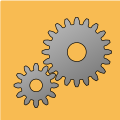Installing the VirtualHub under Tiny Core Linux
 One of our customers asked us how to install the VirtualHub on the Tiny Core Linux distribution. To be honest, we had never heard of this distribution, but we discovered that this distribution made interesting technical choices. Thus, we are going to show you how to install the VirtualHub, or your own application, on Tiny Core Linux.
One of our customers asked us how to install the VirtualHub on the Tiny Core Linux distribution. To be honest, we had never heard of this distribution, but we discovered that this distribution made interesting technical choices. Thus, we are going to show you how to install the VirtualHub, or your own application, on Tiny Core Linux.
| No comment yet | Read more... |
How to get started in LabVIEW with Yoctopuce modules
![]() This week, we provide you with a short tutorial explaining the basis of the use of Yoctopuce modules into LabVIEW. We limit ourselves to a very simple application: turning on and off a light depending on the ambient light level.
This week, we provide you with a short tutorial explaining the basis of the use of Yoctopuce modules into LabVIEW. We limit ourselves to a very simple application: turning on and off a light depending on the ambient light level.
| 4 comments | Read more... |
Driving a stepper motor with a Yocto-IO
 Three years ago, we gave you a small preview of what could be a Yoctopuce module used to drive stepper motors. In the mean time, a lot of time has past, but this module is still not for sale. We do intend to offer it in the future, but if in between you need to drive a stepper motor for a simple application, we may have a solution for you ...
Three years ago, we gave you a small preview of what could be a Yoctopuce module used to drive stepper motors. In the mean time, a lot of time has past, but this module is still not for sale. We do intend to offer it in the future, but if in between you need to drive a stepper motor for a simple application, we may have a solution for you ...
| No comment yet | Read more... |
Installing the GatewayHub with NPM
 We begin the new year with a small improvement on the GatewayHub. We decided to publish the GatewayHub on NPM in order to make its installation easier.
We begin the new year with a small improvement on the GatewayHub. We decided to publish the GatewayHub on NPM in order to make its installation easier.
| No comment yet | Read more... |
The Yoctopuce library as a .NET Assembly
 The most common way to use Yoctopuce modules in an application consists in integrating our library in the source code of the application, in order to be able to interact with the modules through a simple and efficient object oriented interface. But in cases where source code integration is not possible, we have today a new solution to show you: a dynamic library in the shape of a .NET Assembly.
The most common way to use Yoctopuce modules in an application consists in integrating our library in the source code of the application, in order to be able to interact with the modules through a simple and efficient object oriented interface. But in cases where source code integration is not possible, we have today a new solution to show you: a dynamic library in the shape of a .NET Assembly.
| No comment yet | Read more... |


